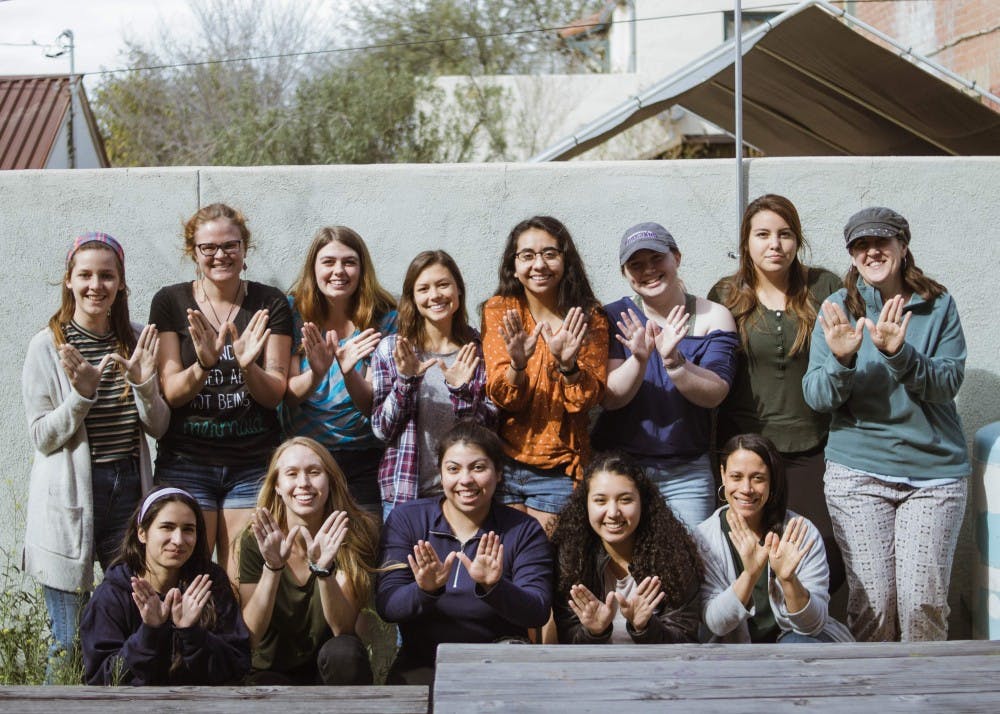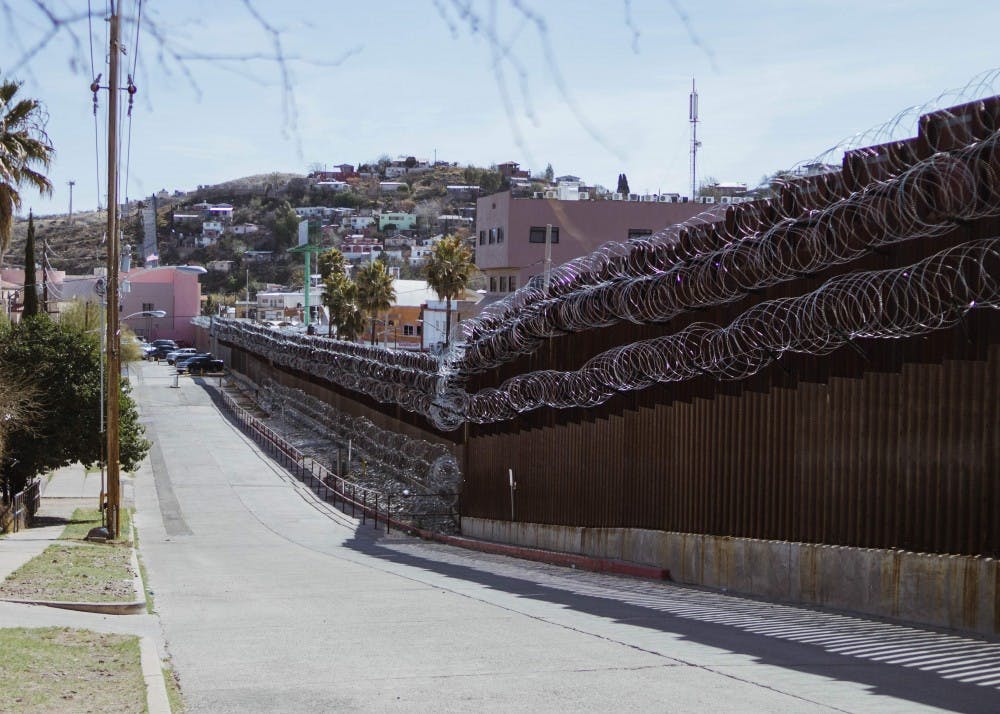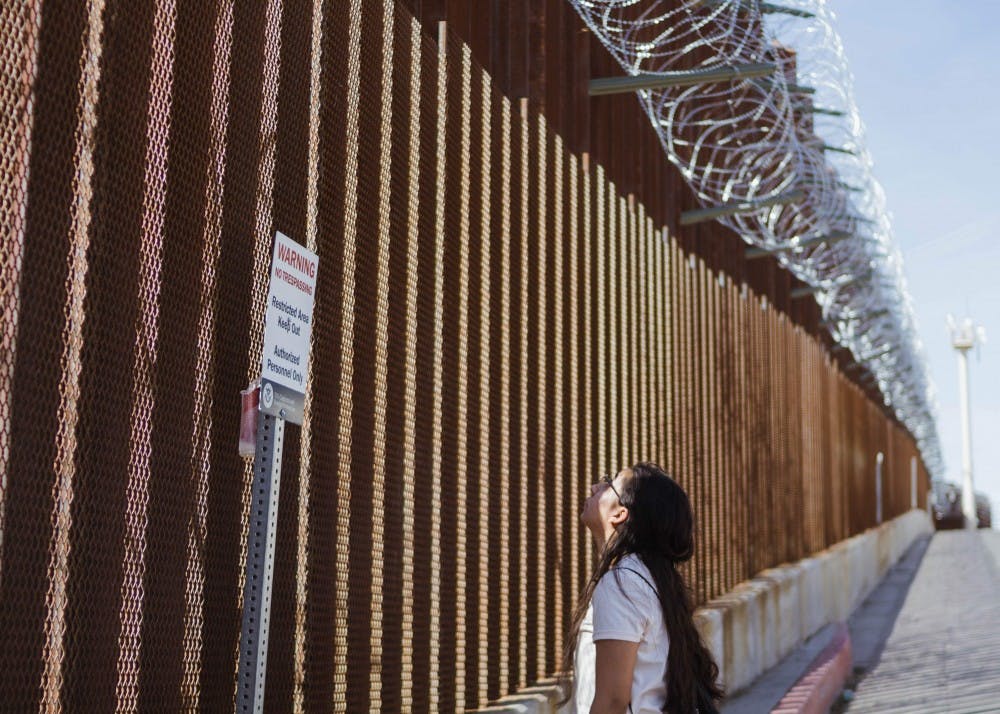On a quiet night in October of 2012, on the Mexican side of the border wall in Nogales, Arizona, a 16-year old boy named José Antonio Elena Rodríguez was shot ten times. The U.S. Border Patrol agent behind the gun would later claim that the unarmed boy had been tossing rocks across the border wall, a crime deserving of eight shots to the back and two to the head.
Over spring break, 11 University of Portland students heard jarring stories like this and many others. The students traveled to southwestern Mexican border wall in Tucson, Arizona as apart of the border immersion sponsored by the Moreau Center.
While other students headed home or to the beach, these students spent seven days in Nogales, Arizona, a town that is split in two by the Mexican border wall, and experienced an intimate view of social justice in the context of immigration.
“I wasn’t really sure what to expect when I was going in, and I went into it not knowing a lot about immigration,” said Abbie Aspinwall, a sophomore social work major. “I was really excited to go and learn.”

This was a statement echoed by many of her peers. Despite their initial interest and eagerness to learn, the students on the border immersion trip could not have expected the profound, inspiring and at times disheartening trip before them.
As tensions rise at the Mexican border, President Trump has called for increased security. In recent months, the border wall has been adorned with additional reinforcement: a razor wire lining that covered the fence from head to toe. Previously, families separated by the wall were able to eat lunch together, to hold hands through the slats of the wall or to kiss. Now, even the slightest shared human touch has been prohibited.

“It’s all about this dehumanization aspect,” said Irene Routté, program manager for Service & Justice and border immersion chaperone. “Like, we’re adding this component of specifically trying to make you feel like you can’t have that human connection and understanding of each other.”
UP partnered with BorderLinks, an educational organization based in the Arizona-Sonora region along the border wall. BorderLinks provides immersive experiences for university-age groups to explore the global, environmental and humanitarian components of immigration and deportation.
Throughout the week, students attended a variety of presentations, seminars and learning-based activities. An activity called an “immigration stimulation” had students follow a scavenger hunt of envelopes to reveal simulated immigration status. They would come to realize that the only way an individual would be granted legal status is if they were white and privileged. They also went for a “desert walk” where they roamed the areas surrounding the border wall and left jugs of water for immigrants.
Some students, like Aspinwall, went on border immersion to further their understanding of an issue they’d only seen represented in news headlines. Others participated for an insight into their own history.

Sarah Ponce is a junior Spanish and biology major and a third-generation Mexican-American. Her grandparents entered the United States in the 1960s, during the final stages of the Bracero program, which encouraged guest workers to enter the U.S. to bring aid to agricultural areas. At the time of her grandfather’s application, he was granted legal status within seven months. Now, the same process can take years to finalize.
Ponce hoped that the border immersion would give her a deeper understanding of her family’s history and experiences as immigrants.
“I definitely understand my privilege better, in terms of the timeline,” Ponce said. “They came at a certain time in history where they were lucky, they were alive at a certain time in history where they were able to do that. Now, I feel like I have a better understanding of myself in the whole system.”
Students mentioned that a particularly surreal aspect of the immersion was the looming physical presence of the border wall. They described hearing children playing and laughing from only a few feet away, but separated incontestably by an entire country.
“I didn’t expect it to be right in the middle of the city of Nogales,” junior psychology major and coordinator Samm Sposito said. “It’s split right down the middle. They just decided, this is the arbitrary line, where you guys are and where we are.”
In search of greater opportunities across the wall, undocumented immigrants turn to dire measures by attempting to dig tunnels, to jump the wall or to face dangerous conditions by hiding in the trunks of cars transporting illegal drugs across the border. In February of 2019, more than 66,000 individuals were apprehended at Southwest Border entry points according to the Department of Homeland Security. After apprehension, they are filtered into the court system.
Students such as Aspinwall and junior nursing major Caity Igarta were especially impacted by sitting in on Operation Streamline, a virtual assembly line of court hearings implemented in Arizona to accelerate processing of the high number of illegal immigrants in custody. This system processes upwards of 70 immigrants within a two hour time period, each day.

Operation Streamline is not a traditional trial so much as an interrogation, Aspinwall explained. Bound in shackles, with lawyers behind them, defendants answer three simple questions: Did you try to cross the border? Are you an American citizen? And finally, how do you plead?
“It’s supposed to be innocent until proven guilty, but they came in in shackles,” Aspinwall said. “I think seeing that, and realizing that every single one of them had a story that they weren’t given the chance to tell because all they could say was yes, no, guilty...It was hard to watch.”
Many defendants also face a language barrier, as they speak native dialects separate from the main English and Spanish spoken in Nogales. After pleading guilty, as the majority do, defendants have acquired a criminal record, making it impossible for them to ever enter the U.S. legally. Within thirty seconds, their lives and opportunities have been changed forever.
“The U.S. justice system is incredibly problematic on many fronts, and we operate on fear rather than compassion,” said chaperone Anne Santiago, political science professor and member of the social justice advisory committee. “This is the most problematic aspect of our policies for me.”
The immersion trip provided unique insights to what BorderLinks has come to refer to as a “Culture of Cruelty” within the Border Patrol Agency. Presenters at BorderLinks described tactics used by border patrol officers to undermine the acts of humanitarian agencies, such as agents slashing gallons of water left in the desert to quench the thirst of traveling groups.
Footage has also shown agents using low-flying helicopters or All Terrain Vehicles (ATVs) to disperse groups in the desert, separating individuals from their guide and leaving them instead to wander in barren terrain and soaring temperatures.
Aspinwall described hearing an especially disturbing story from an Abuse Documentation group, who found an injured group in the desert of Nogales, Sonora. The group agreed to contact border patrol for help. When border patrol arrived, the agent treated the victims with respect and consideration, allowing them time to rest and drink water.
The Abuse Documentation group, grateful for the agent’s humanity, asked for the name of her supervisor so they could commend her actions. Instead, the agent shied away. “No,” she said, “Don’t tell the boys,” referring to her coworkers. For some government agents, compassion has become misconduct.
Although students explored the civil and political components of immigration, some other impacts have received less attention. Sposito described hearing a presentation from a natural scientist that focused on the environmental impact of the border wall. Walls prevent native species from seeking sustenance across the border wall or escaping from a natural disaster such as wildfire or extreme temperatures. Infrastructure built under the wall caused flooding in Nogales in 2014 after blockage prevented sufficient drainage.
“Animals don’t see borders. It doesn’t matter to them,” Sposito said.
Students on the border immersion described a unanimous drive to put their new knowledge to use within the UP community. They’ve discussed plans to negotiate UP status as a sanctuary campus, where undocumented students could be safe from deportation. This issue is no stranger to the UP campus, after a petition circulated in 2016 that received over 1,000 signatures. However, no conclusive measures have been taken.

The students also hope to hold a vigil on campus on October 10, the anniversary of the shooting of José Antonio Elena Rodríguez. In addition, the group described a desire to continue to meet periodically, to keep the impact of their experience fresh in their minds.
“You know, students are busy, and when you come back to campus after an experience it can be easy to go back into your comfort zone,” Routté said. “But I really feel that these students are embodying what they’ve learned, and are so willing to really act back in Portland.”
In the wake of the border immersion, students are left with the memories of their experience.
“I just think that our group was really good together and that we really connected, and we were really vulnerable with one another and able to open up,” said student coordinator Caity Igarta. “It’s definitely something that I would really want to do again.”
For an in-depth look at the experiences of the border immersion, read more on the Moreau Center’s blog.
Gabi DiPaulo is a reporter for The Beacon. She can be reached at dipaulo21@up.edu.








